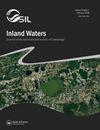利用数据丰富的湖泊参数及其与湖泊特征的关系,在区域尺度上对数据贫乏的湖泊进行建模。
IF 2.3
3区 环境科学与生态学
Q1 LIMNOLOGY
引用次数: 0
摘要
摘要对休闲娱乐和经济相关活动至关重要的湖泊往往地处偏远,研究不够深入,这阻碍了湖泊预测模型在湖泊管理中的应用。本文利用面向过程的MyLake模型,基于12个数据丰富湖泊的子组参数和形态计量学数据,对198个数据贫乏湖泊的水温、冰盖持续时间、溶解氧和光衰减进行了模拟。具体来说,该模型首先使用遗传算法在经过充分研究的湖泊上进行校准。然后,导出了拟合参数与湖泊集水区形态特征之间的简单关系。然后比较了拟合参数和推导参数的模拟结果。用均方根误差(RMSE)表示的拟合优度损失,由于使用估计而不是校准的参数,水温为0.17℃,溶解氧为0.82 mg L-1。然后使用这些一般关系为分布在瑞典各地的198个缺乏数据的湖泊提供模型参数,并对这些湖泊进行建模。总的来说,这种概念证明允许根据湖泊管理的相关性来模拟湖泊,而不是基于广泛的现场数据集的可用性。关键词:湖泊湖泊模型氧热生境气候变化影响模型校准数据贫乏湖泊免责声明作为对作者和研究人员的服务,我们提供此版本的接受稿件(AM)。在最终出版版本记录(VoR)之前,将对该手稿进行编辑、排版和审查。在制作和印前,可能会发现可能影响内容的错误,所有适用于期刊的法律免责声明也与这些版本有关。感谢Koji Tominaga(新加坡南洋理工大学)和Benjamin Laken(英国伦敦cerest公司)对气候数据的检索和准备工作。RMC承认来自拉瓦尔大学北哨兵项目的资助,这在一定程度上要归功于加拿大第一研究卓越项目的资助。加拿大自然科学与工程研究委员会通过“发现基金”项目、加拿大气候科学推进项目“改变加拿大亚北极地区的碳汇”以及北欧quimac研究所(INQ)的支持也得到了认可。GE、DOH、TA和AGF感谢挪威研究委员会项目#224779和#221410的支持。本文章由计算机程序翻译,如有差异,请以英文原文为准。
Towards modeling data-poor lakes at the regional scale using parameters from data-rich lakes and relationships to lake characteristics.
AbstractLakes that are pivotal for recreation and economically relevant activities are often remote and not very well studied, which hinders the application of predictive lake models for their management. Here, we provide an approach to simulate, by means of the process-oriented model MyLake, water temperature, ice cover duration, dissolved oxygen, and light attenuation in 198 data-poor lakes based on parameters obtained for a subgroup of 12 data-rich lakes and morphometric data. Specifically, the model is first calibrated using a genetic algorithm on well-studied lakes. Then, simple relationships between the fitted parameters and lake-catchment morphometric properties are derived. The results of simulations using fitted and derived parameters are then compared. The loss in goodness-of-fit, expressed as root mean square error (RMSE), incurred by using estimated rather than calibrated parameters, is 0.17 oC for water temperature and 0.82 mg L-1 for dissolved oxygen. These general relationships are then used to provide the model parameters for 198 data-poor lakes distributed throughout Sweden and model these lakes. Overall, this proof of concept allows simulating lakes selected based on their relevance for lake management rather than based on the availability of extensive field datasets.Keywords: LakesLake modelingoxythermal habitatsclimate change impactmodel calibrationdata-poor lakesDisclaimerAs a service to authors and researchers we are providing this version of an accepted manuscript (AM). Copyediting, typesetting, and review of the resulting proofs will be undertaken on this manuscript before final publication of the Version of Record (VoR). During production and pre-press, errors may be discovered which could affect the content, and all legal disclaimers that apply to the journal relate to these versions also. AcknowledgmentsWe thank Koji Tominaga (Nanyang Technological University, Singapore) and Benjamin Laken (Cervest Inc., London, United-Kingdom) for the retrieval and preparation of the climate data. RMC acknowledges funding from the Sentinel North program of Université Laval, made possible, in part, thanks to funding from the Canada First Research Excellence program. Support from the Natural Sciences and Engineering Research Council of Canada, through the Discovery Grant program, from the Advancing climate science in Canada project “Changing carbon sinks in subarctic Canada” and from the Institut nordique du Québec (INQ) is also acknowledged. GE, DOH, TA and AGF acknowledge support from the Research Council of Norway projects #224779 and #221410.
求助全文
通过发布文献求助,成功后即可免费获取论文全文。
去求助
来源期刊

Inland Waters
LIMNOLOGY-MARINE & FRESHWATER BIOLOGY
CiteScore
6.10
自引率
9.70%
发文量
34
审稿时长
>12 weeks
期刊介绍:
Inland Waters is the peer-reviewed, scholarly outlet for original papers that advance science within the framework of the International Society of Limnology (SIL). The journal promotes understanding of inland aquatic ecosystems and their management. Subject matter parallels the content of SIL Congresses, and submissions based on presentations are encouraged.
All aspects of physical, chemical, and biological limnology are appropriate, as are papers on applied and regional limnology. The journal also aims to publish articles resulting from plenary lectures presented at SIL Congresses and occasional synthesis articles, as well as issues dedicated to a particular theme, specific water body, or aquatic ecosystem in a geographical area. Publication in the journal is not restricted to SIL members.
 求助内容:
求助内容: 应助结果提醒方式:
应助结果提醒方式:


